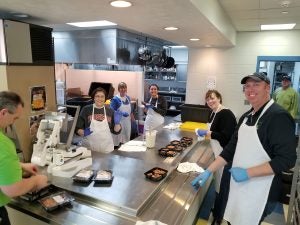It’s a frustrating dichotomy: lots of hungry people and lots of wasted food. It actually seems rather absurd, but it exists anyway.
Enter Cultivate.
Cultivate is a nonprofit based in South Bend, Indiana. And it went unexpectedly viral when its latest pilot program garnered national media attention. Cultivate partnered with two local school districts to reach two goals: reduce food waste and feed hungry kids. Instead of allowing school cafeterias to throw away unserved-but-cooked food, Cultivate rescues the food and sends it home with children from low-income households.
I reached out to Jim Conklin, Cultivate’s co-founder and president, in the midst of the media frenzy. In just a couple weeks, he shared Cultivate’s story with major news corporations, like CBS and USA Today, and sat for television interviews. He also fielded inquiries from around the country by people hoping to start similar programs. His passion and excitement for the project never wavered.

Conklin invited me to visit Cultivate’s humble operation. So I met with him and Todd Zeltwanger, Cultivate’s Director of Fund Development. Currently located in an old mental-health facility, they’re currently bursting at the seams. The freezers are full of food ready for packaging. Bookbags, which are filled with six frozen meals and given to students each Friday, fill the tables. And containers sit ready for volunteers to portion out individual servings.
The idea is actually quite simple: collect surplus food, divide and package it into individual meals, freeze, and distribute the containers to hungry people. Cultivate is basically a logistics company for rescued food.
And while the school programs drew attention to Cultivate, its operations are actually much more expansive. They partner with the University of Notre Dame, local hotels and banquet halls, and other area businesses to rescue the food. The trained chefs at each location know how to properly cool the food, which allows Cultivate to collect it.

Cultivate also has a chef who oversees the packaging of individuals meals. Volunteers are rallied to pair a protein, a starch, and a vegetable. Each carton is plastic sealed with a donated machine. And then it’s into the freezer. A volunteer crew can make about 300 to 600 meals in just a couple hours, depending on experience.
Distribution is largely accomplished by teaming with local food pantries and other charities. Conklin acknowledged that some organizations might see Cultivate as a competitor for feeding the hungry. But he sees Cultivate as a collaborator meeting a different need. Food pantries can serve those with functioning kitchens. And places serving hot meals provide space for those in the area. But Cultivate’s frozen meals provide nourishment for people with access only to a microwave, or those who can’t travel far to eat.
Of course, there’s also the environmental impact. The United States wastes about 30 percent to 40 percent of its food supply. The foods ends up in landfills where it’s left to rot. Farmers can certainly appreciate the hours, effort, and resources wasted for nothing.
So what about agriculture — does Cultivate’s model have a place for us to participate?
Conklin tells me that’s the next step. Cultivate actually developed from the mission of Headsight Inc., an agricultural-services company. So bringing farmers into the mix seems natural. Cultivate is currently building a permanent facility specifically designed for their model. It’ll boast large walk-in coolers, plenty of prep space, and a fully-functioning kitchen.

The kitchen is the key to using fresh-farm produce to supplement the already-cooked foods and create more balanced meals. Although ugly fruits and vegetables are often thrown out, Cultivate will be able to rescue the produce and cook it for the frozen meals. And unmarketable meat, which is still completely safe and edible, is another source they hope to tap from the area’s livestock producers.
“I just want to feed hungry kids,” Conklin tells me. And while it seems like such a simple goal, it has huge implications. Cultivate is building a community effort to feed hungry people, and reduce food waste. The passion and excitement from Zeltwanger and Conklin was palpable. It’s already had a huge impact, and I can’t wait to see how far it goes!
If you’d like to connect with Cultivate, you can visit their website or donate here.
Amanda Zaluckyj blogs under the name The Farmer’s Daughter USA. Her goal is to promote farmers and tackle the misinformation swirling around the U.S. food industry.



